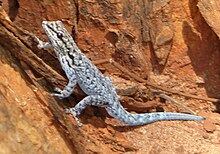The Okavango dwarf gecko or Chobe dwarf gecko (Lygodactylus chobiensis) is a species of gecko found along the Chobe and Zambesi Rivers and into the Okavango Delta, and into Mozambique, Zimbabwe and Zambia.[1][2]
| Okavango dwarf gecko | |
|---|---|

| |
| Scientific classification | |
| Domain: | Eukaryota |
| Kingdom: | Animalia |
| Phylum: | Chordata |
| Class: | Reptilia |
| Order: | Squamata |
| Family: | Gekkonidae |
| Genus: | Lygodactylus |
| Species: | L. chobiensis
|
| Binomial name | |
| Lygodactylus chobiensis FitzSimons, 1932
| |

| |
| Synonyms | |
|
Lygodactylus picturatus subsp. chobiensis FitzSimons, 1932 | |
Description
editA large dwarf gecko (normally 25–30 mm in snout–vent length) with males being slightly larger than the females. It has a blue-grey back covered with large pale spots and a yellow belly. The male throat may be black or pale yellow and has two dark chevrons.[3]
They mature at around 9 months and have a lifespan of 18 months.
Habitat
editThe Okavango dwarf gecko is normally arboreal and can found on tree trunks and sometimes buildings of the tropical savanna and flooded grasslands. It prefers to forage high up in trees and can often be found on acacia, baobab and mopane trees.[1]
Diet
editTheir diet is mainly ants and termites.[4]
Reproduction
editReproduction occurs throughout the year and two hard-shelled eggs (5 × 6.5 mm) are laid every 8 weeks beneath the tree bark or in disused termite mound. The eggs hatch in about 125 days and the young geckos are about 30 mm in length.[4]
References
edit- ^ a b c Broadley, D.G. & Martiz, B. (2010). "Lygodactylus chobiensis". The IUCN Red List of Threatened Species. 2010. IUCN: e.T174118A7018090. doi:10.2305/IUCN.UK.2010-4.RLTS.T174118A7018090.en.
- ^ Lygodactylus chobiensis at the Reptarium.cz Reptile Database. Accessed 9 April 2015.
- ^ "Africa Wild Reptile Book: Lizards - Photos & Descriptions". Retrieved 1 November 2014.
- ^ a b Branch, William R. (1998). Field Guide to Snakes and Other Reptiles of Southern Africa. p. 247. ISBN 9781868720408. Retrieved 1 November 2014.
